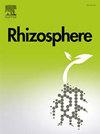The fungal endophyte Pochonia chlamydosporia boosts growth and defence in black pepper (Piper nigrum L.): Insights from transcriptomics and functional studies
IF 3.5
3区 生物学
Q1 PLANT SCIENCES
引用次数: 0
Abstract
Pochonia chlamydosporia var. chlamydosporia (Goddard) Zare & W. Gams 2001 is a versatile fungal endophyte known for its biocontrol properties against plant-parasitic nematodes and its ability to stimulate plant growth. This study integrates temporal transcriptomic analysis with functional validation through pot culture trials to elucidate its dual role in black pepper (Piper nigrum L.). High-throughput RNA sequencing at two colonization stages (14 and 28 days post-inoculation, dpi) identified 203,092 transcripts, including 65,354 differentially expressed genes (DEGs). Genes involved in hormone biosynthesis, nutrient uptake, and stress tolerance were significantly upregulated, revealing mechanisms of enhanced growth and resilience. Defence-related DEGs linked to jasmonic acid and ethylene signalling, and phenylpropanoid biosynthesis, indicated induced systemic resistance. These transcriptomic findings were corroborated by qRT-PCR and phenotypic data from greenhouse trials, which demonstrated significant improvements in plant growth parameters, nutrient content, and root colonization. Together, these insights advance our understanding of P. chlamydosporia as a promising bioinoculant for sustainable agriculture.

真菌内生菌衣孢子菌促进黑胡椒(Piper nigrum L.)的生长和防御:转录组学和功能研究的见解
chlamydosporia变种chlamydosporia (Goddard) Zare &;W. Gams 2001是一种多功能真菌内生菌,以其对植物寄生线虫的生物防治特性和促进植物生长的能力而闻名。本研究将时间转录组学分析与盆栽试验功能验证相结合,阐明其在黑胡椒(Piper nigrum L.)中的双重作用。在两个定殖阶段(接种后14天和28天)进行高通量RNA测序,鉴定出203,092个转录本,包括65,354个差异表达基因(DEGs)。参与激素生物合成、营养吸收和胁迫耐受的基因显著上调,揭示了生长和恢复能力增强的机制。与茉莉酸和乙烯信号以及苯丙类生物合成相关的防御相关deg表明诱导了系统性抗性。这些转录组学发现得到了qRT-PCR和温室试验表型数据的证实,证明了植物生长参数、营养含量和根系定植的显著改善。总之,这些见解促进了我们对衣原体孢杆菌作为一种有前途的可持续农业生物接种剂的理解。
本文章由计算机程序翻译,如有差异,请以英文原文为准。
求助全文
约1分钟内获得全文
求助全文
来源期刊

Rhizosphere
Agricultural and Biological Sciences-Agronomy and Crop Science
CiteScore
5.70
自引率
8.10%
发文量
155
审稿时长
29 days
期刊介绍:
Rhizosphere aims to advance the frontier of our understanding of plant-soil interactions. Rhizosphere is a multidisciplinary journal that publishes research on the interactions between plant roots, soil organisms, nutrients, and water. Except carbon fixation by photosynthesis, plants obtain all other elements primarily from soil through roots.
We are beginning to understand how communications at the rhizosphere, with soil organisms and other plant species, affect root exudates and nutrient uptake. This rapidly evolving subject utilizes molecular biology and genomic tools, food web or community structure manipulations, high performance liquid chromatography, isotopic analysis, diverse spectroscopic analytics, tomography and other microscopy, complex statistical and modeling tools.
 求助内容:
求助内容: 应助结果提醒方式:
应助结果提醒方式:


